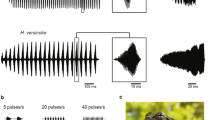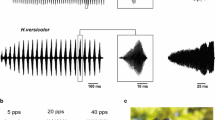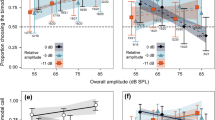Summary
-
1.
The mating (advertisement) calls of two sibling species of gray treefrogs,Hyla versicolor andHyla chrysoscelis, are spectrally identical but differ in trill rate; being higher forH. chrysoscelis. Single-unit recordings were made from the torus semicircularis of both species to investigate the neural mechanisms by which this species-specific temporal feature is analyzed. Using sinusoidally amplitude-modulated (AM) white noise as a stimulus, the temporal selectivity of these midbrain auditory neurons could be described by five response categories: ‘AM nonselective’ (34%); ‘AM high-pass’ (7%); ‘AM low-pass’ (6%); ‘AM band-suppression’ (12%); ‘AM tuned’ (40%).
-
2.
The distributions of temporal tuning values (i.e., modulation rate at which each AM-tuned unit responds maximally) are broad; in both species, neurons were found which were tuned to modulation rates greater than those found in their advertisement calls. Nevertheless, the temporal tuning values forH. versicolor (median=25 Hz) were significantly lower than those forH. chrysoscelis (median=32.5 Hz).
-
3.
The temporal selectivities of AM band-suppression neurons were found to be temperature dependent. The modulation rate at which a response minimum was observed shifted to higher values as the temperature was elevated. These results extend our earlier findings of temperature-dependent temporal selectivity in the gray treefrog.
-
4.
The selectivity of band-suppression and AM-tuned neurons to various rates of amplitude modulation was largely, but not completely, indepndent of whether sinusoidal or natural forms of AM were used.
Similar content being viewed by others
Abbreviations
- AM :
-
amplitude modulated
References
Bibikov NG (1980) The reaction of the torus semicircularis units ofRana temporaria to the signals simulating the mating call temporal characteristics. Zool Zh 59:577–586
Bibikov NG, Gorodeckaja ON (1980) The reactions of neurons in the midbrain auditory center of the frog to amplitude modulated tones. Neirofiziologia 12:264–270
Brenowitz EA, Rose GJ, Capranica RR (1985) Neural correlates of temperature coupling in the vocal communication system of the treefrog (Hyla versicolor). Brain Res (in press)
Capranica RR, Rose G (1983) Frequency and temporal processing in the auditory system of anurans. In: Neuroethology and behavioral physiology. Huber F, Markl H (eds) Springer, Berlin Heidelberg New York Tokyo, pp 136–152
Fellers G (1979) Aggression, territoriality, and mating behavior in North American treefrogs. Anim Behav 27:107–119
Gerhardt HC (1974) Mating call differences between eastern and western populations of the treefrog,Hyla chrysoscelis. Copeia 1974:534–536
Gerhardt HC (1978) Temperature coupling in the vocal communication system of the gray tree frog,Hyla versicolor. Science 199:992–994
Gerhardt HC (1982) Sound pattern recognition in some North American treefrogs (Anura: Hylidae): Implications for mate choice. Am Zool 22:581–595
Harnischfeger G (1979) An improved method for extracellular marking of electrode tip positions in nervous tissue. J Neurosci Methods 1:195–200
Hoy RR (1974) Genetic control of acoustic behavior in crickets. Am Zool 14:1067–1080
Johnson C (1960) Species recognition in theHyla versicolor complex. Texas J Sci 18:361–364
Mayr E (1963) Animal species and evolution. Harvard University Press, Cambridge
Ralin B (1976) Comparative hybridization of a diploid-tetraploid cryptic species pair of tree frogs. Copeia 1976:191–195
Rose G, Capranica RR (1981) Selectivity of single units in the central auditory system of the leopard frog (Rana pipiens) to AM signals. J Acoustic Soc AM Abst 009:PS95
Rose G, Capranica RR (1983) Temporal selectivity in the central auditory system of the leopard frogRana pipiens. Science 219:1087–1089
Rose G, Capranica RR (1984) Processing amplitude modulated sounds by the auditory midbrain of two species of toads: Matched temporal filters. J Comp Physiol A 154:211–219
Rose G, Capranica RR (1985) Sensitivity to amplitude modulated sounds in the anuran auditory nervous system. J Neurophysiol 53:446–465
Schildberger K (1984) Temporal selectivity of identified neurons in the cricket brain. J Comp Physiol A 155:171–185
Walkowiak W (1980) The coding of auditory signals in the torus semicircularis of the fire-bellied toad and the grass frog: responses to simple stimuli and to conspecific calls. J Comp Physiol 138:131–148
Walkowiak W (1984) Neuronal correlates of the recognition of pulsed sound signals in the grass frog. J Comp Physiol A 155:57–66
Wasserman AO (1970) Polyploidy in the common tree toadHyla versicolor Le Conte. Science 67:385–386
Author information
Authors and Affiliations
Rights and permissions
About this article
Cite this article
Rose, G.J., Brenowitz, E.A. & Capranica, R.R. Species specificity and temperature dependency of temporal processing by the auditory midbrain of two species of treefrogs. J. Comp. Physiol. 157, 763–769 (1985). https://doi.org/10.1007/BF01350073
Accepted:
Issue Date:
DOI: https://doi.org/10.1007/BF01350073




